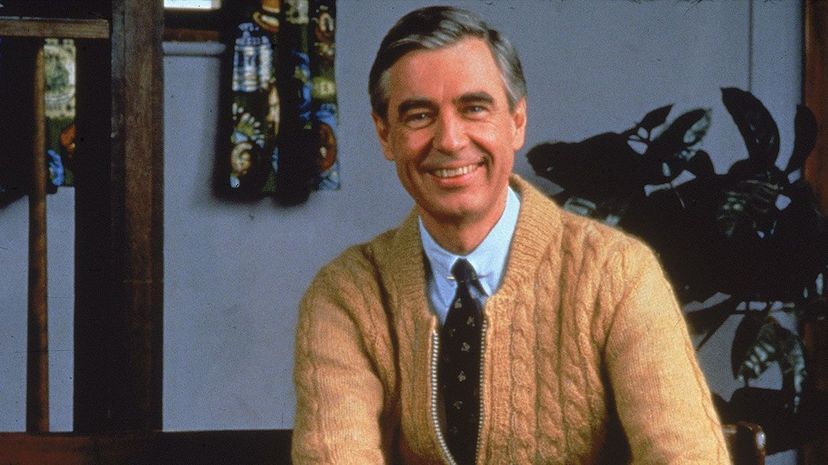
TV personality and all-round nice guy Fred Rogers is the subject of a popular documentary and new movie starring Tom Hanks. But there was more to Mister Rogers than was seen on TV. Here are five things you might not know about him.
Advertisement

TV personality and all-round nice guy Fred Rogers is the subject of a popular documentary and new movie starring Tom Hanks. But there was more to Mister Rogers than was seen on TV. Here are five things you might not know about him.
Advertisement
Fred Rogers was an only child until he was 11 — a shy, chubby outsider who was bullied by other kids. In the book "I'm Proud of You," author Tim Madigan tells how Rogers' life was turned around by a popular high school classmate named Jim Stumbaugh. Stumbaugh was an athlete who was injured and laid up in the hospital and Rogers volunteered to take him his schoolbooks. At the school's 50th year class reunion, Rogers recalled in a speech how their friendship liberated him. "There he was, probably the best-known, smartest, most active person in our class and he welcomed me day after day. And what's more, he seemed to want to get to know me. I learned to trust him and told him some of my deepest feelings ... By the time he got out of the hospital and back to school, he was telling all of his friends that 'that Rogers kid is OK.' In fact, he quietly included me in everything he thought I'd like." Rogers went on to become student council president and editor of the yearbook "largely because I had somebody who believed in me and wasn't afraid to say so."
Advertisement
Yes friends, Mister Rogers hated some stuff too. And one of them was television. After graduating from Rollins College with a degree in music competition, he worked for a few years as a floor manager for some NBC TV shows, which he didn't enjoy. "People throwing pies at each other's faces" just seemed "demeaning." Rogers told CNN that "I got into television because I hated it so. And I thought there's some way of using this fabulous instrument to nurture those who would watch and listen."
Advertisement
While studying at seminary, Rogers also started developing a show that was a precursor to "Mister Rogers' Neighborhood." He also took classes in child development. Although he was ordained a minister in the Presbyterian church in 1962, he never had a church of his own. He saw "Mister Rogers' Neighborhood" as his ministry. "He believed ... that he was strong enough to enter into battle with that — that machine that medium — and to wrestle with it until it yielded to him, until the ground touched by its blue shadow became hallowed and this thing called television came to be used 'for the broadcasting of grace through the land,'" Tom Junod wrote in a very famous Esquire profile of Mister Rogers.
Advertisement
Although Rogers was not out protesting in the streets, he was very in tune with the issues of the day. During the week that "Mister Rogers' Neighborhood" first aired in 1968, he shared his antiwar beliefs on TV. That same year, he also introduced a black character, Francois Clemmons, as Officer Clemmons. He was the first African-American to have a recurring role on a kids' TV show ("Sesame Street" debuted in 1969.) Clemmons at first didn't want to take the role, as he had a negative opinion of policemen. But he ended up staying for decades in the part. One famous scene has the two men resting their feet together in a tub of water.
"The icon Fred Rogers not only was showing my brown skin in the tub with his white skin as two friends, but as I was getting out of that tub, he was helping me dry my feet," Clemmons recalled in an interview with NPR in 2016.
Advertisement
However, the show was criticized for not having the diversity of other children's TV shows. Rogers only introduced one more recurring minority character to the neighborhood, in 1975. Clemmons, who was also gay, was asked by Rogers to keep his sexuality in the closet or else he would be removed from the show. Clemmons went along with it but said he felt Rogers changed his views over time — as did many Americans.
Advertisement
Rogers saw his show as less about teaching kids to read and more about "teaching them to read the expression on [their] mother's face," as he once said. Many of the episodes dealt with feelings and inner worth, and the show's pacing was much slower than that of a typical children's show. Angela Santomero, the creator of "Blue's Clues," says she modeled the pacing of her hit kids' show off of his.
"We used to speak a lot about the pausing and pacing, and how deliberately slow it was. This came from Fred: When you talk to camera, and you pace it adequately, you're going to talk back to him. That's what I did. I talked to him. I believed he liked me just the way that I was," she says in a story for Mental Floss.
Advertisement
Please copy/paste the following text to properly cite this HowStuffWorks.com article:
Advertisement